This past weekend, August 4-5, 2011, I saw my first rocket launch live from Kennedy Space Center. Well actually, I was at Kennedy, the rocket launched from Cape Canaveral Air Force Station, Launch Complex 41, about three miles away.
See, it’s those details that I love. Maybe it’s the sign of a true geek, or just my borderline OCD.
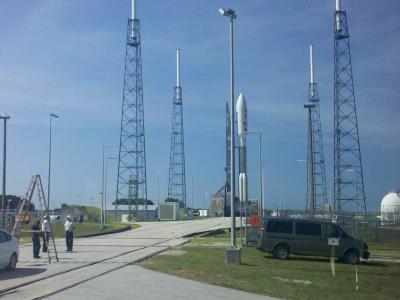
Juno's ride, an Atlas V in 551 configuration (5-meter payload fairing, 5 solid rocket strap-ons). Under the fairing is a Centaur second stage and Juno. Around the launch platform are four giant lightning rods on towers.
The Juno spacecraft was launched on a five-year trek to Jupiter, in a beautiful trajectory that makes perfect sense when you see it. It’ll loop out in an elliptical solar orbit that takes it just past Mars, like it wants to get to Jupiter but can’t quite make it.
It will swing back towards Earth, inevitably, as if in defeat. “Hey buddy, could you help me out here?” It will pick up enough energy from the slingshot pass for a bigger orbit that just reaches Jupiter, where it will be captured and spend a year in a polar orbit studying the amazing planet.
But that’s not what I came to talk about. The occasion for me being at the launch was remarkable.
NASA is taking social media, especially Twitter, very seriously. Yes it seems whimsical, silly, even stupid, right down to the name “Tweetup,” a meet-up of Twitter users. As it turns out, there’s brilliance in the whimsy.
The Tweetup was a two-day affair, based in a large tent pitched in the classic Kennedy media area next to the famous countdown clock, in the shadow of the enormous Vehicle Assembly Building. Even the old CBS News shack is there. The invited guests were 150 tweeps (Twitter people), normal people with extraordinary interests and talents, each one screened and badged. Six were foreign nationals.
After the launch, on Friday night at dinner with a JPL executive he described us as “multipliers.” Each individual there was like the eyes and ears for at least a hundred others. It makes sense.
I never imagined the unprecedented access we would have. This was nothing like the theme-park-like tours offered across the way at the visitor’s center. Don’t get me wrong — I’ve enjoyed those tours immensely and highly recommend a trip there. But a NASA Tweetup puts you right in the thick of things.
We spent the first morning in the tent, beginning with everyone introducing themselves. We had beautiful material packets, and a program with everyone’s Twitter handle. We had talks from notables such as Scott Bolton, Juno’s principal investigator; Jim Adams, the planetary science deputy director at NASA; and the mission designer Steve Matousek.
The best part was that we could ask them questions — both in the form of “press conference” style questions and informal chats. They knew we were their people. The talks were streamed live on Ustream by Kennedy’s professional A/V crew.
I had a voice mail message that night from my mom back in California saying she saw me asking a question at NASA on TV. I still don’t know what she was watching or which of my questions she saw, but I know it was from one of her local news outlets. My guess is that they picked up a question I asked of Jim Adams about the connection between this Atlas V rocket and the Atlas rockets that launched Mercury in the 60’s (their name is the only thing in common).
During the event, all my “rocket geek” history started twitching, from my days as a kid building and launching model rockets, and following along with every mission configuration with my own kit-built static models.
Then came the afternoon tour. At Cape Canaveral Launch Complex 17 we saw the Delta II rocket in its service structure ready to be loaded with the Grail mission launching next month. Reps from NASA launch services and United Launch Alliance stood next to each other embodying their strange and strained relationship of government and industry — part sales and business, part science, exploration, and bureaucracy. ULA has a warehouse with five Deltas available for missions. “I’ll take one,” I said.
They walked us into the Atlas Space Operations Center, where we were told not to take pictures, though you can see it in all of the Atlas launch coverage. Next, in the first of several OMG moments, we were escorted into a large hangar and stood ten feet from the Atlas V booster waiting to take MSL, the Mars Curiosity rover, to Mars in November. Here we could take pictures.
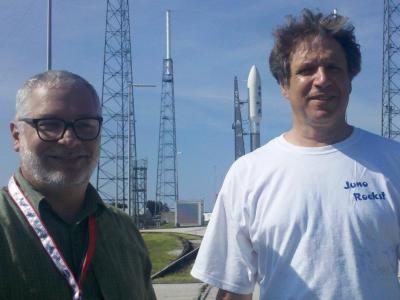
Mojo poses with Juno Principal Investigator Scott Bolton at Launch Complex 41 the day before launch.
The next surprise came when we were dropped off at Launch Complex 41, a few hundred feet from the Atlas/Centaur/Juno stack ready to fly. P.I. Scott Bolton was there with his family, joining us to gaze at the rocket and spacecraft, joking that “it’s all a boondoggle! The payload is really full of cork.” Together we were all spending one last moment with the hardware nearby.
Our last stop was the VAB, the enormous Vehicle Assembly Building, built for the Saturn V rocket, and never a part of any tour. Until recently, it was a busy working industrial place, and the quiet and emptiness inside was eerie and sad.
Nestled in one corner of the VAB was shuttle Discovery, its forward reaction control system removed as part of its preparation to be a museum piece.
There wasn’t a dry eye getting back on the bus.
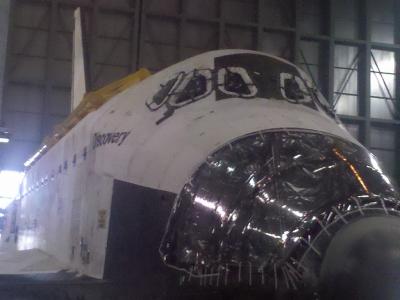
Discovery in the VAB with its forward RCS removed in prep for museum duty. The other orbiters were at the Orbiter Processing Facility.
Emotionally drained and amazed, we all adjourned for the night, hoping for worthy launch weather the next day. It was looking good. Friday morning, August 5, would be launch day.
And yet NASA wasn’t finished dazzling us. I thought the program was teasing us by listing NASA Administrator Charlie Bolden among the speakers. It was no tease. There he was shaking hands, clasping shoulders, speaking and taking questions, and joining us for the group photo.
Andy Aldrin spoke. Maybe that name sounds familiar — he’s Buzz Aldrin’s son, and now an executive at United Launch Alliance. We had lots of great questions for him about “man-rating” the Atlas V, which he had fun correcting to “human-rating.”
Off-mic I shouted “How about alien-rating?”
With a smile he said, “Hey if there’s a business case for it, I’m all over it.”
We asked Andy about the elephant in the room: his being the son of Buzz Aldrin. “That’s the first time I’ve heard my dad referred to as an elephant.” Where he grew up, it seemed like everyone’s dad was an astronaut. “My dad was cool because he could pole vault.” (At least no one asked him about Dancing with the Stars.)
The biggest ovation may have been for Charlie Bolden, but the second biggest was for Bill Nye @theScienceGuy. The room was full of people, perhaps a generation behind me, who grew up with his entertaining science features. They were enthralled to be sharing a tent and watching a launch with him. There was a long line for autographs after the launch.
Bill Nye fielded a great question about getting girls into science and technology. He had some interesting insights around the different timing in development between girls and boys and when we teach algebra. That needs fixing, somehow. “When someone learns algebra they learn to predict the future.”
The launch itself had all the best features and drama of a launch: a downward counting clock, a helium recharge anomaly finally traced to a ground system, a range safety hold, and finally a mind-blowing launch sequence that ended with fully-deployed solar panels.
I took one launch picture, which isn’t worth posting. Mostly I just enjoyed watching it. My favorite launch production is ULA’s gorgeous highlight reel that’s truly “rocket porn.” Watch a couple of their launch highlight reels and tell me if you don’t agree.
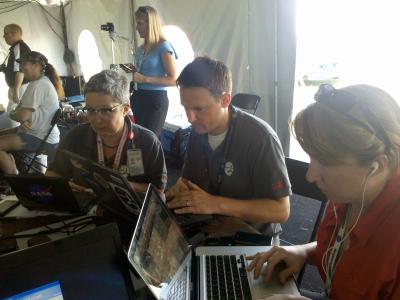
Three prominent NASA tweeters during a launch hold. Left to right, Jane Houston Jones @CassiniSaturn, Preston Dyches @NASAJuno, Stephanie Smith @NASAJPL
I stayed the next couple of days with Jane in the Cocoa Beach Courtyard by Marriott. We traded smiles and stories with the small army of scientists and technicians who had descended on Florida for the launch, everyone sharing the afterglow. The lobby and bar held a constant gathering of Juno folk.
On Saturday we traveled with Preston Dyches (@NASAJuno) and his wife Margot to the Universal Orlando resort. We just had to visit the new Wizarding World of Harry Potter. The signature attraction, “Harry Potter and the Forbidden Journey,” really raises the bar for a theme park thrill ride. Amazing tech and execution.
Much of the fun that day was to have Preston in the back seat of Jane’s rental car contemplating what to tweet from the @NASAJuno Twitter account for that day. We all agreed that a tweet exactly 24 hours after the launch would be ideal. From his iPhone, he used JPL’s Solar System Simulator to generate a plot that showed Juno already beyond lunar orbit.
When the time came to actually send the tweet, we were all having frozen “butterbeers” at the Hog’s Head pub in Universal’s Islands of Adventure. For a while we wondered if the signal from AT&T would be steady enough, but they eventually came through. Here’s the tweet he sent.
Sunday, Jane and I visited the official public KSC visitor’s center, trolled the gift shop, and watched Hubble 3-D in the IMAX theater. We were amazed and delighted to see her Galileo telescope on display in the IMAX theater as part of a Galileo exhibit. Sunday night I flew home.
There are so many other delicious details that I took back with me:
I love the Atlas V with its massive efficient Russian RD-180 engines.
I love how the main propellant RP-1 (Rocket Propellant 1, or Refined Petroleum 1, basically very pure kerosene) is liquid at ambient temperature, while the LOX liquid oxygen requires cryogenic handling.
I was fascinated to recognize that the white section of the booster was really just ice around the LOX tank, while the lower RP-1 section kept it’s metallic bronze color. I wonder how much ice weight they have to compensate for at launch?
I’m amazed that they can mount five solid rocket boosters around the Atlas in a non-symmetrical pattern, and the main engine can compensate.
I had no idea that ULA was a joint venture between Boeing and Lockheed-Martin in an effort to minimize redundancies.
I’d love to spend a day in Andy Aldrin’s office.
It’s remarkable to see that they build Atlas vehicles in a vertical assembly building, then roll them out to the pad, whereas Deltas are stacked at the pad in a service structure, which they then roll away for launch.
NASA is giving these Tweetups a first-class budget with serious attention to detail. The tent roof had industrial-strength WiFi nodes mounted every twenty feet. Each round table had a power strip. The tent was fed with tons of air conditioning. It’s probably some of the most efficient spending on public outreach they’ve ever done.
The pictures are all mine, taken with the mediocre camera in my original Motorola Droid. They’ll serve. Click each for the full-size.
Thank you for bringing out my latent rocket geek! Go Juno!

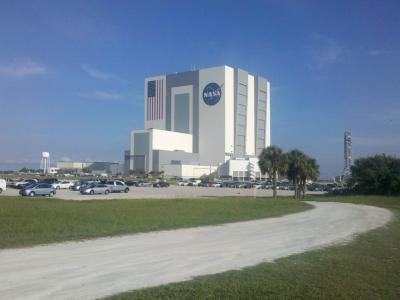
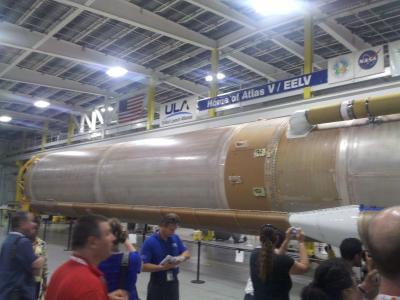
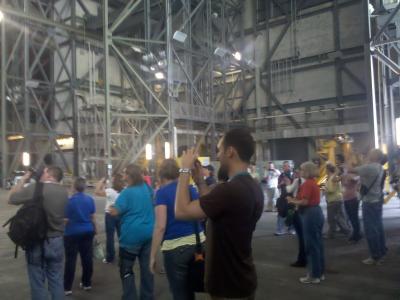
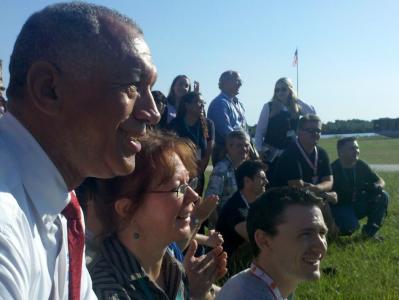
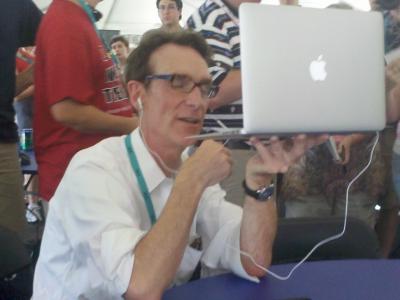
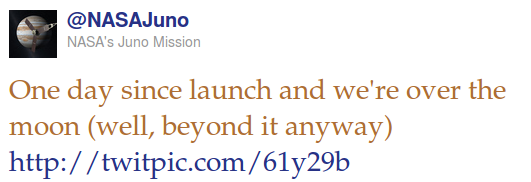
Awesome wrap-up post, Mojo. I especially liked reading about the two days after the tweetup and your “delicious details” that you took away from the who experience. NASA really has done a great job of outreach and excitement-building within the aerospace community.
Thanks for sharing your experience!
Thanks for making your trip an educational experience that us teachers can use in the classroom. This makes it possible to show students things that the general public tours will never see.
Here’s another great first-person account of the Tweetup by Emily Carney @ThsSpcAvailable http://kittysneezes.com/index.php?option=com_content&view=article&id=913:calling-occupants-of-interplanetary-craft-junoatlas-v-nasa-tweetup&catid=21:essays&Itemid=30
[…] Fast forward nearly 8 years and I find myself sitting in the shadows of Kennedy Space Center writing a blog about my own adventures at the launch of the mission which launched my own career at JPL. There will be many blogs, photo essays, and tweets from the 150 Tweetup attendees and many other launch guests. Mojo was one of the lucky 150 attendees at the tweetup and his blog is here. […]